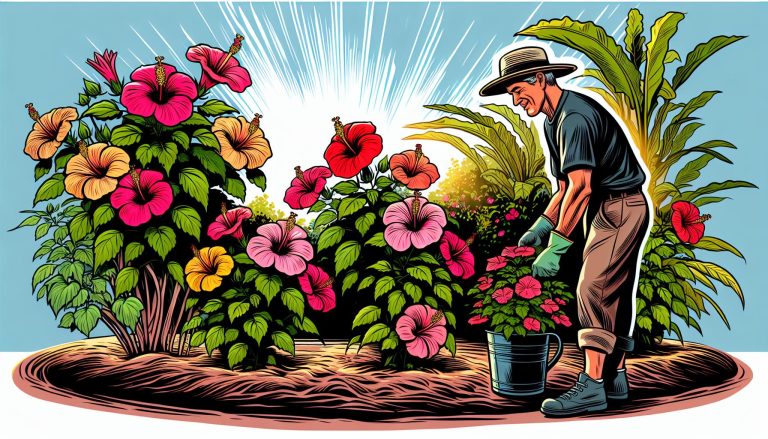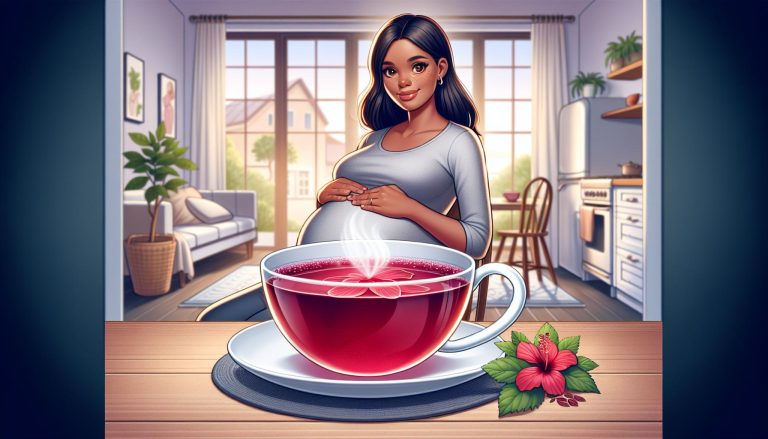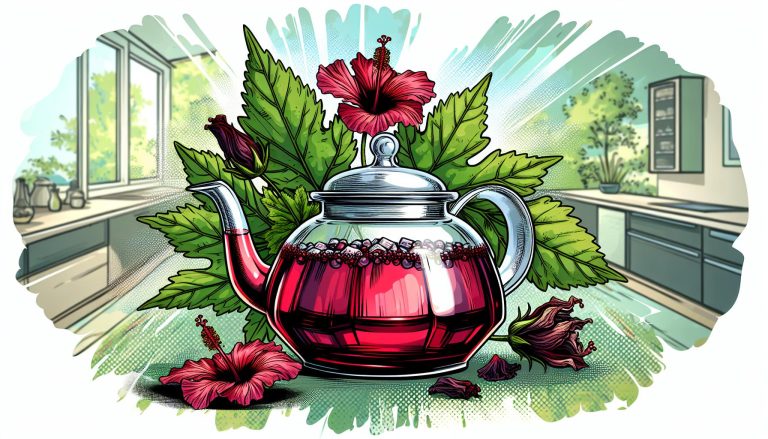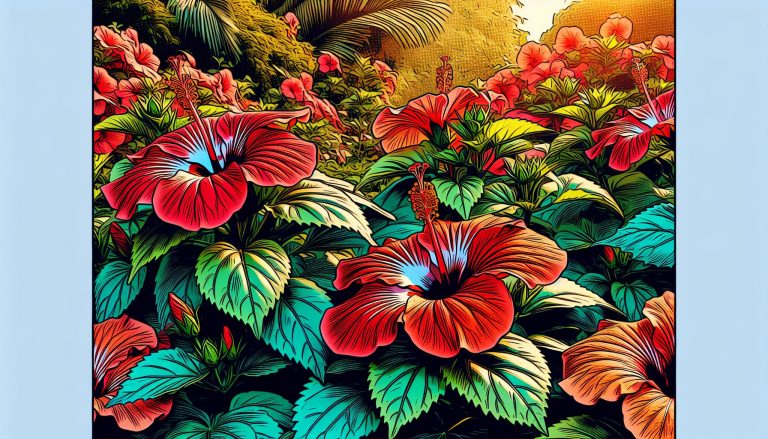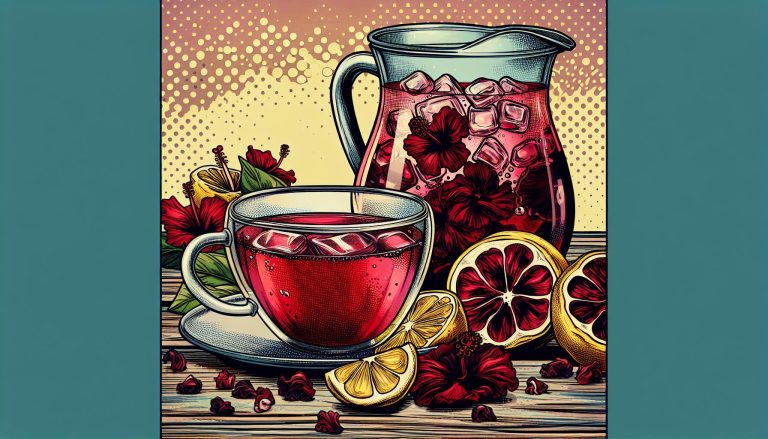Brew Perfect Hibiscus Tea: Easy Steps for a Delicious & Healthy Drink
As a tea enthusiast, I’ve always been drawn to the vibrant color and tangy flavor of hibiscus tea. This refreshing beverage isn’t just delicious; it’s also packed with health benefits that make it a popular choice for many.
I’ve spent years perfecting my hibiscus tea-making technique, and I’m excited to share my knowledge with you. Whether you’re looking to enjoy a cool glass on a hot summer day or warm up with a comforting cup in winter, hibiscus tea is incredibly versatile. In this article, I’ll guide you through the simple steps to create the perfect brew, from selecting the right ingredients to mastering the steeping process.
What Is Hibiscus Tea?
Hibiscus tea is a vibrant, ruby-red infusion made from the dried calyces of the Hibiscus sabdariffa plant. It’s known for its tart, cranberry-like flavor and refreshing qualities. I’ve found that this caffeine-free herbal tea is enjoyed both hot and cold in cultures worldwide, from Egypt’s karkade to Mexico’s agua de jamaica.
The main ingredient, hibiscus, belongs to the Malvaceae family and is native to warm, tropical regions. There are hundreds of hibiscus species, but Hibiscus sabdariffa is specifically cultivated for tea production. The plant’s large, colorful flowers aren’t used for the tea; instead, it’s the fleshy red calyces (the part that supports the flower) that are harvested, dried, and used to make the infusion.
Nutritionally, hibiscus tea is rich in vitamin C, minerals, and antioxidants. It’s particularly high in anthocyanins, which give the tea its distinctive color and contribute to its potential health benefits. These compounds have been associated with various positive effects, including supporting heart health and potentially aiding in weight management.
Here’s a quick nutritional breakdown of hibiscus tea per 100ml serving:
| Nutrient | Amount |
|---|---|
| Calories | 37 |
| Carbohydrates | 9.6g |
| Vitamin C | 14mg |
| Calcium | 8mg |
| Iron | 0.17mg |
I’ve discovered that hibiscus tea’s unique flavor profile makes it a versatile ingredient in culinary applications. It’s used not only as a beverage but also in syrups, jellies, and even as a natural food coloring. Its tangy taste complements both sweet and savory dishes, adding depth and complexity to recipes.
Health Benefits of Hibiscus Tea
Hibiscus tea offers numerous health benefits, making it a popular choice for wellness enthusiasts. Here’s a breakdown of its key advantages:
- Lowers blood pressure: Regular consumption of hibiscus tea helps reduce both systolic and diastolic blood pressure.
- Supports heart health: The antioxidants in hibiscus tea protect against heart disease by reducing bad cholesterol levels.
- Boosts immune system: Rich in vitamin C, hibiscus tea strengthens the immune system and fights off infections.
- Aids weight management: Studies show hibiscus tea may help with weight loss by inhibiting the production of amylase, an enzyme that breaks down carbs and starches.
- Improves liver health: Antioxidants in hibiscus tea protect the liver from oxidative stress and reduce the risk of fatty liver disease.
- Anti-inflammatory properties: Hibiscus tea contains anti-inflammatory compounds that help reduce inflammation throughout the body.
- Promotes skin health: The vitamin C content in hibiscus tea supports collagen production, contributing to healthier, more youthful-looking skin.
| Nutrient | Amount per 100ml |
|---|---|
| Vitamin C | 54 mg |
| Anthocyanins | 1.7-2.5 mg |
| Polyphenols | 51-60 mg |
I’ve found that incorporating hibiscus tea into my daily routine has improved my overall well-being. Its antioxidant-rich profile and potential health benefits make it an excellent addition to a balanced diet. As with any dietary change, it’s important to consult with a healthcare professional before using hibiscus tea for medicinal purposes.
Choosing the Right Hibiscus for Tea
Selecting the appropriate hibiscus for tea is crucial for achieving the best flavor and health benefits. I’ve explored various options and found that the quality of hibiscus significantly impacts the final brew.
Fresh vs. Dried Hibiscus
Fresh hibiscus flowers provide a vibrant, slightly sweeter taste compared to dried varieties. However, dried hibiscus is more readily available and has a longer shelf life. I prefer using dried hibiscus for its concentrated flavor and convenience. Dried hibiscus calyces retain more of their nutritional value and are easier to store. When using fresh hibiscus, I select flowers that are bright in color and free from blemishes.
Types of Hibiscus Flowers
Several hibiscus varieties are suitable for tea-making, each offering unique flavors and properties:
- Hibiscus sabdariffa: The most common variety for tea, known for its tart flavor and deep red color.
- Hibiscus rosa-sinensis: Produces a milder tea with a slightly sweet taste.
- Hibiscus acetosella: Offers a more subtle flavor profile with earthy undertones.
- Hibiscus syriacus: Creates a delicate tea with floral notes.
I typically opt for Hibiscus sabdariffa due to its robust flavor and high antioxidant content. When choosing hibiscus, I look for organic, whole calyces rather than crushed or powdered forms to ensure the best quality and flavor in my tea.
How to Make Hot Hibiscus Tea
I’ve perfected two methods for brewing delicious hot hibiscus tea: steeping and boiling. Each technique offers a unique flavor profile and intensity, catering to different preferences and time constraints.
Steeping Method
The steeping method produces a delicate and nuanced hibiscus tea. Here’s how I do it:
- Boil water in a kettle or pot
- Place 1-2 teaspoons of dried hibiscus flowers per cup of water in a teapot or infuser
- Pour the hot water over the flowers
- Steep for 5-7 minutes, depending on desired strength
- Strain the tea into cups
- Sweeten to taste with honey or sugar if desired
This method preserves the subtle flavors of hibiscus while minimizing bitterness. It’s ideal for those who prefer a lighter, more refreshing brew.
Boiling Method
The boiling method creates a stronger, more robust hibiscus tea. Here’s my go-to process:
- Add 1-2 teaspoons of dried hibiscus flowers per cup of water to a pot
- Pour cold water over the flowers
- Bring the mixture to a boil over medium-high heat
- Reduce heat and simmer for 10-15 minutes
- Remove from heat and strain into cups
- Add sweetener if desired
This technique extracts more flavor and color from the hibiscus, resulting in a deeper, more intense brew. It’s perfect for those who enjoy a bolder tea or want to use it as a base for other beverages.
Creating Iced Hibiscus Tea
Iced hibiscus tea is a refreshing alternative to hot brews, perfect for warm days or as a cool, flavorful drink anytime. I’ve perfected two methods for creating delicious iced hibiscus tea:
Cold Brew Method
- Place 1/4 cup of dried hibiscus flowers in a large jar or pitcher.
- Add 4 cups of cold water.
- Stir gently to ensure all flowers are submerged.
- Cover and refrigerate for 8-12 hours.
- Strain the tea into a clean pitcher.
- Sweeten to taste with honey, agave nectar, or your preferred sweetener.
- Serve over ice, garnished with a lemon slice or fresh mint leaves.
This method produces a smooth, less acidic tea with a subtle flavor profile.
Hot Brew and Chill Method
- Prepare hot hibiscus tea using the steeping or boiling method.
- Allow the tea to cool to room temperature.
- Refrigerate for 2-3 hours until chilled.
- Serve over ice, adding sweetener if desired.
- Garnish with orange slices or a cinnamon stick for added flavor.
This technique results in a bolder, more intense flavor that holds up well when diluted with ice.
Flavor Variations
Experiment with these additions to create unique iced hibiscus tea blends:
- Citrus zest (lemon, lime, or orange)
- Fresh ginger slices
- Lemongrass stalks
- Crushed berries (strawberries or raspberries)
- Cucumber slices
- Herbs like mint, basil, or rosemary
Add these ingredients during the brewing process or as a garnish when serving.
| Serving Style | Description |
|---|---|
| Classic | Serve in tall glasses with ice and a lemon wedge |
| Sparkling | Mix chilled tea with carbonated water for a fizzy twist |
| Cocktail Base | Use as a mixer for vodka or rum-based cocktails |
| Popsicles | Freeze sweetened tea in molds for a cool treat |
Iced hibiscus tea isn’t just refreshing; it’s a versatile drink that can be customized to suit various tastes and occasions. Its vibrant color and tart flavor make it an eye-catching and delicious addition to any beverage lineup.
Flavor Enhancements for Hibiscus Tea
Enhancing the flavor of hibiscus tea opens up a world of delicious possibilities. I’ve experimented with various additions to complement and elevate the tea’s natural tartness, creating unique and refreshing blends.
Natural Sweeteners
Hibiscus tea’s natural tartness pairs well with a variety of sweeteners. I prefer using honey, which adds a floral sweetness that complements the tea’s flavor profile. Agave nectar offers a neutral sweetness, while maple syrup imparts a rich, caramel-like taste. For a low-calorie option, stevia works well, though it’s important to use it sparingly to avoid overpowering the tea’s natural flavor. Dates, when blended into a syrup, provide a natural sweetness with added nutritional benefits.
Herb and Fruit Combinations
Combining hibiscus with herbs and fruits creates complex flavor profiles. I love adding fresh mint leaves for a cooling effect, or lemongrass for a citrusy note. Rosemary or lavender introduce an aromatic dimension, while ginger adds a spicy kick. For fruit combinations, orange slices complement the tea’s tartness, while muddled berries like strawberries or raspberries enhance its fruity notes. Adding a cinnamon stick during brewing imparts a warm, spicy flavor perfect for cooler months. Experimenting with these combinations allows for customized blends tailored to personal preferences and seasonal availability.
Storing Hibiscus Tea
Proper storage is crucial for maintaining the quality and flavor of hibiscus tea. I’ve found that storing hibiscus tea correctly extends its shelf life and preserves its vibrant color and tangy taste. Here’s how I store both dried hibiscus flowers and brewed tea:
Storing Dried Hibiscus Flowers
- Keep in an airtight container
- Store in a cool, dry place away from direct sunlight
- Avoid exposure to moisture
- Use within 1 year for optimal flavor
Dried hibiscus flowers maintain their potency for up to 12 months when stored properly. I always check for any signs of mold or unusual odors before use.
Storing Brewed Hibiscus Tea
- Refrigerate in a sealed glass container
- Consume within 3-5 days for best taste
- Avoid adding sweeteners before storage
- Shake well before serving
Brewed hibiscus tea keeps in the refrigerator for 3-5 days. I’ve noticed it’s best to add sweeteners or flavoring just before serving to prevent fermentation.
- Pour cooled tea into ice cube trays
- Freeze for 2-3 hours until solid
- Transfer cubes to a freezer-safe bag
- Use within 6 months
Freezing hibiscus tea in ice cube form is perfect for adding a burst of flavor to water or cocktails. The frozen cubes retain the tea’s antioxidants and flavor for up to 6 months.
| Storage Method | Shelf Life | Best Practices |
|---|---|---|
| Dried Flowers | 1 year | Airtight container, cool & dry place |
| Brewed Tea | 3-5 days | Refrigerated, sealed glass container |
| Frozen Tea | 6 months | Freezer-safe bag, used as ice cubes |
By following these storage methods, I ensure my hibiscus tea remains fresh and flavorful, ready to enjoy whenever I crave its distinctive taste and health benefits.
Conclusion
Crafting the perfect hibiscus tea is an art that’s well worth mastering. From selecting the right variety to experimenting with flavors I’ve shared my journey to help you create your ideal brew. Whether you prefer it hot steaming or icy cold hibiscus tea offers a world of possibilities. Its health benefits and versatility make it a fantastic addition to any lifestyle. So grab your kettle or pitcher and start exploring the vibrant world of hibiscus tea. You’ll be amazed at how this simple beverage can transform your daily routine and delight your taste buds.



